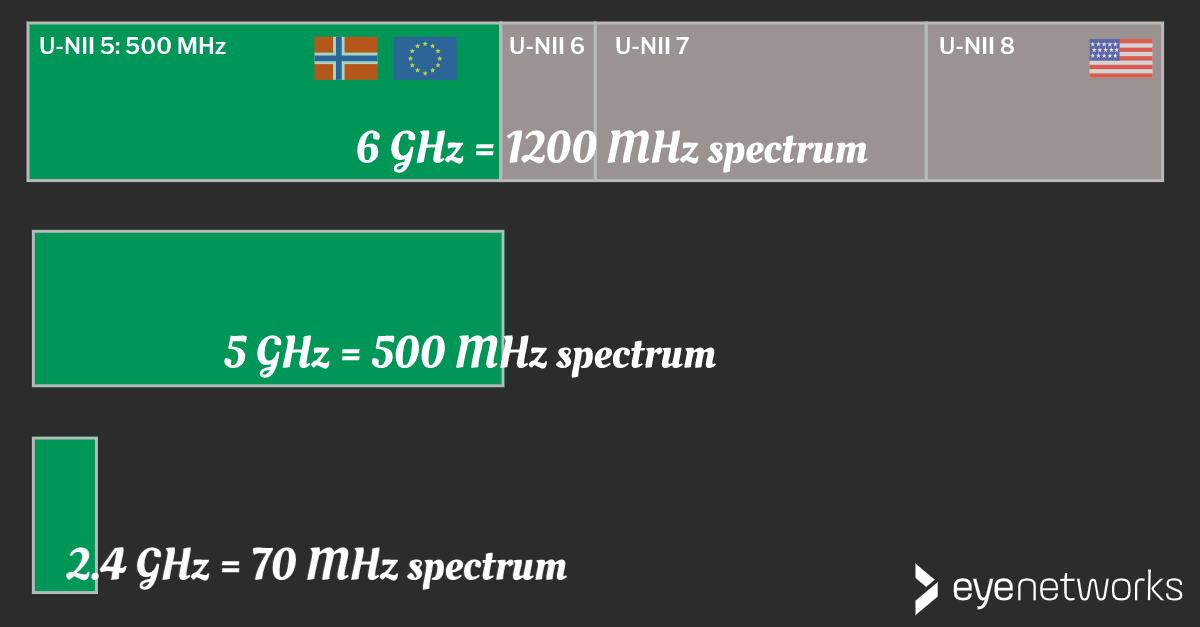Why was the 6 GHz band so highly anticipated for wifi, and what do you need to use it?
What is the 6 GHz band?
6 GHz is the “newest” radio frequency band for wireless internet, which was first made available for wifi usage in Norway in 2021.
This was a much-needed expansion; the 2.4 GHz band has been crowded for a long time, and increased wifi usage and the number of connected gadgets were also starting to become noticeable on the 5 GHz band.
The 6 GHz band is included in Wi-Fi 6E and Wi-Fi 7, currently the latest version of wifi.
So 6 GHz WiFi is not the same as Wi-Fi 6:
- Wi-Fi 6 corresponds to the 802.11ax standard . This standard basically applies to the two most established frequency bands for wifi: 2.4 and 5 GHz.
- Products labeled Wi-Fi 6 do not support 6 GHz. If a product supports both 802.11ax and communication on the 6 GHz band, it should be labeled Wi-Fi 6E, which is a separate certification from the industry organization WiFi Alliance .
What Is The Point (And Problem?) With 6 GHz?
What we here briefly and simply call 6 GHz is actually a spectrum of 1200 MHz from 5.925 to 7.125.
By comparison:
- The 2.4 GHz frequency band has a spectrum of 70 MHz
- The 5 GHz band is 500 MHz.
So the point of expanding the frequencies available for wifi was the prospect of making the space/airtime constraints much less tight. On the other frequency bands, wifi networks compete both with each other and with other wireless standards, such as Bluetooth. There has also not been any room for increasing the bandwidth to 80 or 160 MHz to increase throughput, as that would create massive amounts of interference for the surroundings.
The 6 GHz band thus brings with it long-awaited bandwidth and capacity for wireless communication. In the long term, we expect that access to new frequencies will provide massive improvements in the user experience for bandwidth-demanding applications.
The problem with expanding to 6 GHz has been that this part of the spectrum was not unused, but was reserved for licensed use.
How Much Of The 6 GHz Band Is Available?
Changes in the usage of frequencies must be approved by local and regional authorities, and more and more countries have opened up, either for the entire spectrum or for what is called “low 6 GHz” or U-NII-5, the lower 500 MHz.
- In the EU and Norway, it is the lower 500 MHz that has been opened up.
- Countries that have approved the entire 6 GHz spectrum for wifi and other unlicensed usage are in the minority, but include the USA and South Korea, among others.
- The WiFi Alliance has an overview of the status worldwide.
The use of frequencies in Norway is regulated by the General Authorisations Regulations, which are administered by the Norwegian Communications Authority (NKOM). The revised regulations that opened up the low 6 GHz bands entered into force on July 1, 2021 .
How to Get Started With Wifi on the 6 GHz Band
What do you need and what problems might you encounter?
To communicate on the 6 GHz band, the first and most important requirement is that both the wireless access point and the wifi client must support 6 GHz communication.
This means that:
- Both access point and client must support Wi-Fi 6E or Wi-Fi 7
- The access point must be tri-band, meaning it has radios for three frequency bands. If you have Wi-Fi 7 equipment that is dual band, two bands are supported, and they will always be 2.4 and 5 GHz.
Also note that to achieve 6 GHz communication between nodes in a mesh network (backhaul communication), all mesh nodes must both support the standard and be triband.
Possible Compatibility Issues
The rollout of 6 GHz wifi in Norway is still not substantial, so we have limited information about specific compatibility issues, but our testing so far indicates that:
- Many problems are avoided by actively ensuring that all clients are fully system-updated at all times. For a PC, this may involve manually updating drivers.
- Make sure that both access points and clients are set to the correct region, so that they do not operate on different frequencies. Remember that the available frequency spectrum is different from Norway if the equipment is intended for, for example, South Korea or the USA.
